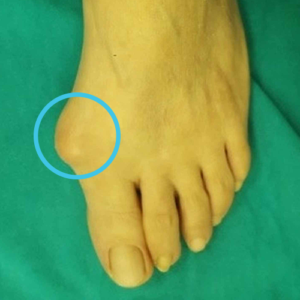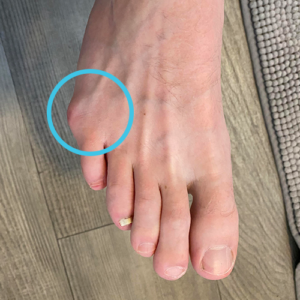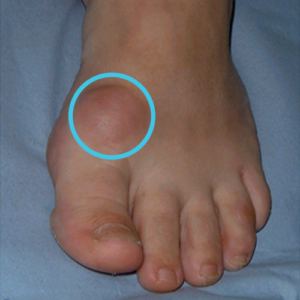Bunions
Hallux Valgus Bunion, Tailor Bunion, Hallux Rigidus
A bunion, medically known as hallux valgus, is often perceived as a bump on the side of the big toe. However, it signifies a more complex alteration in the bony structure of the forefoot. This condition occurs when the big toe deviates towards the second toe instead of pointing straight ahead, causing the bones to shift out of alignment and form the characteristic bunion bump.
Bunions are a progressive disorder, initially marked by the leaning of the big toe. Over time, this misalignment gradually alters the angle of the bones, leading to a more pronounced bump. Symptoms typically manifest in the later stages of the condition, although some individuals may remain asymptomatic throughout the progression.
Causes of Bunions
Bunions are most often caused by an inherited faulty mechanical structure of the foot. It is not the bunion itself that is inherited but certain foot types that predispose an individual to developing a bunion.
While wearing shoes that crowd the toes does not directly cause bunions, it can exacerbate the deformity, leading to a more rapid progression. Consequently, symptoms may appear sooner in individuals who frequently wear such footwear.
Bunion Symptoms
Symptoms, which occur at the site of the bunion, may include:
- Pain or soreness
- Inflammation and redness
- A burning sensation
- Possible numbness
Symptoms occur most often when wearing shoes that crowd the toes, such as shoes with a tight toe box or high heels. This may explain why women are more likely to have symptoms than men. In addition, spending long periods of time on your feet can aggravate the symptoms of bunions.
Types of Bunions
Hallux Valgus Bunion
Hallux valgus is a condition in which the big toe migrates laterally toward the second toe. This results in a bump on the inner side of the foot know as a bunion. It is related to a combination of genetic factors, activities and inheritance. Some patients who have this condition do not have symptoms. Sometimes symptoms can be relieved just by modifying the shoe to have enough room in the forefoot to accommodate the changed shape.

Tailor’s Bunion
Tailor’s bunion, also called a bunionette, is a prominence of the fifth metatarsal bone at the base of the little toe. The metatarsals are the five long bones of the foot. The prominence that characterizes a tailor’s bunion occurs at the metatarsal head, located at the far end of the bone where it meets the toe. Tailor’s bunions are not as common as bunions, which occur on the inside of the foot, but they are similar in symptoms and causes.

Hallux Rigidus
Hallux rigidus is a form of arthritis affecting the metatarsophalangeal (MTP) joint at the base of the big toe. The MTP joint connects the first metatarsal bone to the big toe. Hallux rigidus is characterized by stiffness and limited range of motion in the big toe, causing pain and difficulty during activities involving toe movement. Hallux rigidus is often mistaken for a bunion due to its location and pain.

Bunion Diagnoses
Bunions are readily apparent—the prominence is visible at the base of the big toe or side of the foot. However, to fully evaluate the condition, the foot and ankle surgeon may take x-rays to determine the degree of the deformity and assess the changes that have occurred.
Because bunions are progressive, they do not go away and will usually get worse over time. But not all cases are alike—some bunions progress more rapidly than others. Once your surgeon has evaluated your bunion, a treatment plan can be developed that is suited to your needs.
Nonsurgical Treatments
Sometimes observation of the bunion is all that is needed. To reduce the chance of damage to the joint, periodic evaluation and x-rays by your surgeon are advised.
In many other cases, however, some type of treatment is needed. Early treatments are aimed at easing the pain of bunions, but they will not reverse the deformity itself. These include:
- Changes in shoewear. Wearing the right kind of shoes is very important. Choose shoes that have a wide toe box and forgo those with pointed toes or high heels, which may aggravate the condition.
- Padding. Pads placed over the area of the bunion can help minimize pain. These can be obtained from your surgeon or purchased at a drug store.
- Activity modifications. Avoid activity that causes bunion pain, including standing for long periods of time.
- Medications. Oral nonsteroidal anti-inflammatory drugs (NSAIDs), such as ibuprofen, may be recommended to reduce pain and inflammation.
- Icing. Applying an ice pack several times a day helps reduce inflammation and pain.
- Injection therapy. Although rarely used in bunion treatment, injections of corticosteroids may be useful in treating the inflamed bursa (fluid-filled sac located around a joint) sometimes seen with bunions.
- Orthotic devices. In some cases, custom orthotic devices may be provided by the foot and ankle surgeon.
When Is Surgery Needed?
If nonsurgical treatments fail to relieve bunion pain and when the pain of a bunion interferes with daily activities, it is time to discuss surgical options with a foot and ankle surgeon. Together you can decide if surgery is best for you.
A variety of surgical procedures is available to treat bunions. The procedures are designed to remove the bump of bone, correct the changes in the bony structure of the foot and correct soft tissue changes that may also have occurred. The goal of surgery is the reduction of pain and deformity.
In selecting the procedure or combination of procedures for your particular case, the foot and ankle surgeon will take into consideration the extent of your deformity based on the x-ray findings, your age, your activity level and other factors. The length of the recovery period will vary, depending on the procedure or procedures performed.

